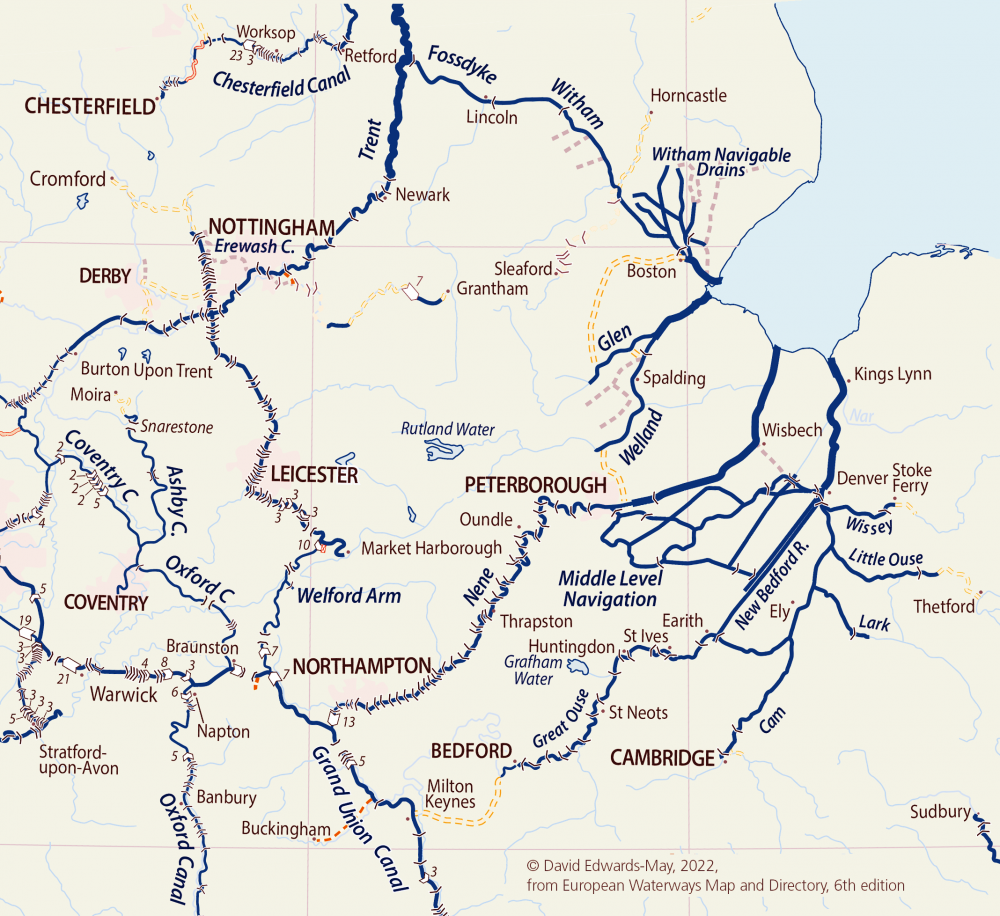East Midlands canals map (click to open)
Chesterfield Canal
- Boat length : 72’ or 21.95m
- Boat width : 6’10” or 2.08m
- Draft : 3’2” or 0.98m
- Headroom : 7’1” or 2.15m
The Chesterfield Canal is a site of Special Scientific Interest on account of its rare aquatic plant life, and all 46 miles really are a haven for wildlife and make for pleasant cruising. Known locally as the Cuckoo Dyke, there are 59 narrow and 6 wide locks to put you through your paces. Originally built to transport commodities between Nottinghamshire, South Yorkshire and Derbyshire, a fun fact is that the stone used to build the Houses of Parliament was quarried at North Anston near Rotherham and transported along this canal on its way to London. Rescued from dereliction, the Chesterfield Canal Trust has the bold ambition to complete all the outstanding renovation works (it has already restored 37 locks and 11 bridges along a 12 mile stretch) in time for the Chesterfield’s 250th anniversary in 2027. They have a fighting chance as there are less than 9 miles to go.
The most famous local landmark is the extraordinarily twisted spire of Chesterfield’s Parish Church of St Mary and All Saints and railway buffs will enjoy a visit to the Barrow Hill Roundhouse Railway Centre. If it is peace and quiet you are after, an afternoon’s stroll around Linacre Reservoir is restorative in itself.
Leicestershire and Northampton Canal
- Boat length : 72’ or 21.95
- Boat width : 7’ or 2.13m
- Draft : 3’3” or 1m
- Headroom : 7’ or 2.13m
Completed in 1810, this 48 mile long waterway is now part of the Grand Union Canal and comes complete with an aqueduct, the Saddington Tunnel which is half a mile long, and 22 locks, so there is plenty to keep you busy and diverted. Initially intended as a missing link in the journey from the East Midlands coalfields to the London markets, within thirty years of its completion, competition from the railways meant that traffic declined and necessary maintenance was therefore not carried out. It was later bought up by the Grand Junction canal who thought that installing an inclined plane lift beside the Foxton locks would encourage industrial traffic to use the route, but the grip of the railways on freight transport was just too tight and the boat lift was closed in 1929.
The reservoirs which feed the canal are a haven for wildlife and you will often see herons and the lesser spotted water vole as you cruise along. The best day out on the Leicester and Northampton canal has to be at Foxton locks. The 10 locks combined to make what was once the longest and steepest flight in the country – no wonder the canal’s owners thought that a boat lift might be a more attractive prospect for bargees. Nowadays you can see the remains of this, while 4000 boats a year continue to pass up and down the lock flight, which is now Grade Two Listed. There are two pubs, two cafes and you can hire day boats in order to get a taste of life on the water. Don’t miss the Foxton Canal museum, which has recently been refurbished and is extremely child friendly.
Middle Level Navigations
- Boat length : 80’ or 24.38m
- Boat width : 11’ or 3.36m
Drainage work on the Fenlands between the River Nene and the Great Ouse has been a challenge since the 1480s, when work was first started digging channels to protect this large area below sea level from flooding. During the 1640s the Dutch were enlisted to help, when renowned engineer Sir Cornelius Vermuyden brought with him some of the expertise gleaned from managing the Polders in the Netherlands and waterways were dug large enough to be used by commercial traffic. Work at protecting the area from the sea has been an ongoing challenge: in 2010 the second largest pumping station in Europe was installed and is now integrated with a network of 100 other pumping stations to keep the waterways navigable and the land dry. Today there are 90 navigable miles for you to discover as well as six locks.
The bird life is stunning and that may be enough to keep you amused in itself. Travel buffs might be interested to spend a day on the Nene Valley Railway which is regularly plied by old steam trains and if culture is your thing, then don’t miss the beautiful 13th century cathedral in Peterborough. If you have wheels and can travel to Helpston, poet John Clare’s cottage is a complete delight; bought by a trust in 2005 it has been lovingly restored using traditional methods and has a quintessential English garden, overflowing with hollyhocks, snapdragons and honeysuckle.
British-Irish waterway regions – Northern | East Midlands | West Midlands | Welsh | Southern | Scottish | Irish
French waterway regions – North | North-East | North-Central | West | Centre | South-East | South | South-West

